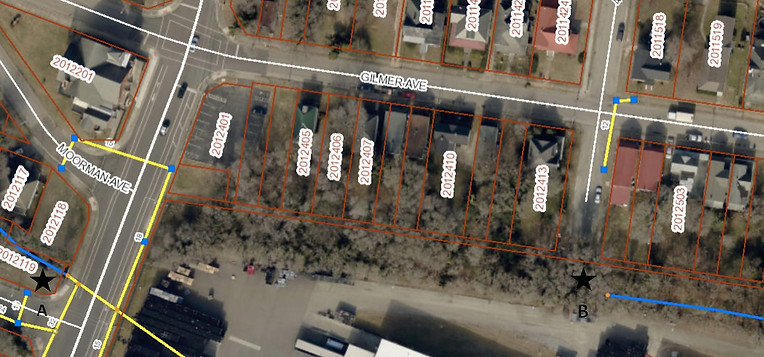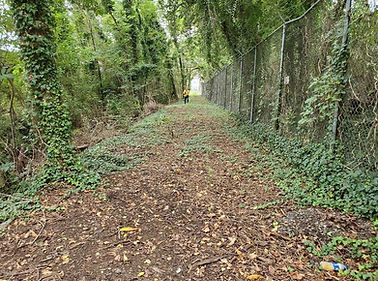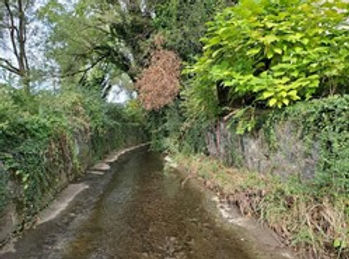
Daylighting Cedar Run
In 2016, a Virginia Tech Design team performed preliminary design work for a project to daylight portions of Cedar Run (Trout Run), including the section that runs underneath the Coca-Cola plant. The project was the idea of Tom Cain, a member of NNEO, who served as the client for the design team. A previous effort had been made by volunteers organized by NNEO, along with the City of Roanoke, to begin the removal of brush from the open portion of the channel. The proposed plan was to continue cleaning up this open portion of the stream upstream of the plant, and to reroute the flow from a culverted portion of the stream under the plant, to a natural drainageway located on the north/east sides of the plant. Daylighting the entire stream would preserve and enhance the natural hydrology of the stream, improve water quality, and allow the stream to serve as an outdoor lab for the nascent G. W. Carver Environmental Center.

Daylighting Cedar Run will restore the channel to a more natural condition, and help to mitigate downstream and downtown flooding by redirecting runoff into a natural channel and reducing peak flows by increased infiltration and regained access to its floodplain. This project also provides an opportunity to educate the community on stormwater management techniques and low impact development (LID) that could be used to decrease stormwater fees in the community. The intent of this project is to lay the ground work to revitalize the community and its economy, and involve the community in the design process. Daylighting Cedar Run will not only address flash flood concerns, but also improve the livability of the community and provide walkable access from the neighborhood to downtown.
After discussions with folks from Coca-Cola and the Stormwater Division of the City of Roanoke, a community meeting, organized by One Valley, was held at the Coca-Cola plant on May 2, 2019. At that meeting, the preliminary student design for stream daylighting of Cedar Run was discussed, along with the possibilities of expanding the greenway along the exposed channel for increased pedestrian access to and from downtown. After hearing from neighborhood citizens, both about their concerns and support, as a next step, the folks from Stormwater offered to fund a feasibility study to better delineate the project’s footprint on the neighborhood and to develop a ballpark cost estimate.
Wetlands Studies and Solutions Inc. (WSSI) was originally contracted by Stormwater to perform the analysis, but a preliminary investigation by WSSI identified hydraulic structure design elements outside of their expertise that needed to be addressed. Stormwater then contracted with Mattern & Craig to conduct the study in the Fall of 2019. The resulting preliminary feasibility study, referred to as the “10% design” study, went through several iterations between Stormwater and the consultant.
The resulting 10% design study was completed mid December 2019 and revealed an aspect of the stream channel that had not been noticeable previously – that the midpoint of the bypass channel (point B in picture below) was actually higher in elevation than where the new channel would start on 5th Street (point A). This condition placed severe restraints on the resulting design and called for pumping, considerable excavation, a reduction in the hoped-for stormwater runoff benefits, and infringement on the Coca-Cola facility. Thus, while the project may be feasible, it is less than desirable with a hefty price tag of more than $1 million, and a less than desirable “natural” channel.

I'm a paragraph. Click here to add your own text and edit me. It's easy.
A community meeting planned for the Spring of 2020 was cancelled due to the onset of the Covid-19 pandemic. Eventually, a virtual Zoom meeting was held on December 2, 2020. At that meeting, the consensus was that the stream daylighting of Cedar Run around the Coca-Cola plant was not worth pursuing any further. However, it was pointed out that the goals of the original study were still relevant.
Those goals are:
-
to connect the community to their stream and serve as an educational and recreational resource,
-
to extend existing connections to the downtown area (including a greenway segment), and
-
to improve stormwater management in the area.
These goals can still be addressed in alternative ways that we intend to brainstorm and discuss in the following year. Here are a few ideas that have already been mentioned:
• Stormwater management
-
install various green infrastructure practices at demonstration homeowner and business sites in the area to reduce storm runoff and to reduce tax bills from impervious areas.
-
work with the City's new Green Infrastructure Crew.
-
partner with Virginia Tech student senior design teams.


• Linkage to the Greenway System
-
resolve North Trail access/alleyway issue with residents.
-
create a "hidden streams" educational trail or educational guided tours to explain the history of many urban hidden streams.
-
include the current exposed segments of Cedar Run (although partially overgrown) in a trail or other walking tour.


A community brainstorming session to generate additional ideas of ways to meet these goals will be forthcoming.